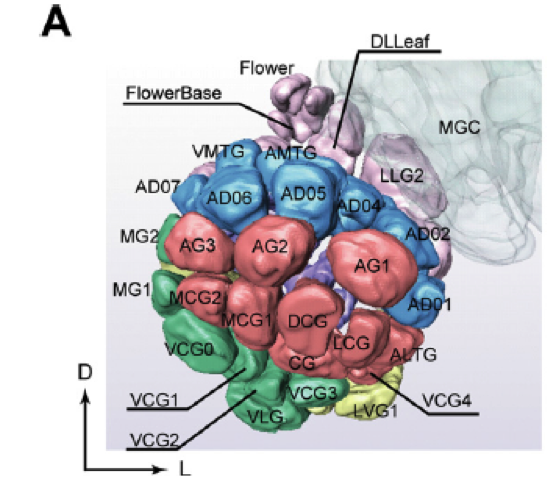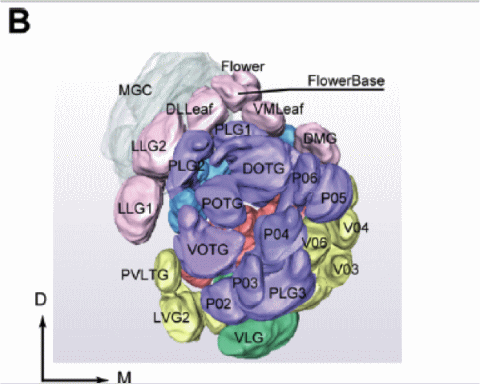Structure of the Antennal Lobe
back
Only a single type of olfactory receptor neurons projects to a glomerulus, which forms a dense neuropil isolated by surrounding glia cells from other glomeruli. The macroglomerular complex receives input from pheromone-sensitive olfactory receptor neurons and has been an important model system for investigating olfactory information processing.
Cell bodies of antennal lobe
neurons are arranged more or less clearly in clusters. In the
silkmoth, three main clusters are found, the anterior (AC), medial
(MC), and lateral (LC) clusters, named according to their position
with respect to the antennal lobe neuropil.
In the
macroglomerular complex, there are three regions: cumulus, toroid,
and horseshoe. Receptor neurons responsive to bombykol project to
the toroid while receptor neurons sensitive to bombykal project to
the cumulus [Kanzaki et al., 2003].Anatomically,
toroid and cumulus appear somewhat intermingled dorsally.
The glomeruli in the silkmoth antennal lobe have been mapped and can be identified based on their shape and position [Kazawa et al., 2009].There
is a small amount of variability in the number of glomeruli as some
glomeruli appear to have a tendency to split up into smaller
glomeruli in some individuals. Glomeruli gradually depart from an
ideal spherical shape which is seen near the anterior surface of
the brain in deeper regions of the antennal lobe, possibly due to
the fact that there are also other elements such as fiber tracts to
accommodate for in a spatially limited volume.

Figure.
Glomerular structure of the silkmoth antennal lobe. Optical
sections obtained by confocal microscopy (left) have been segmented
and combined into a 3D reconstruction map (right).D,Dorsal;MC,
Medial cell cluster;MGC,
Macroglomerular complex;L,Lateral;LC,Lateral
cell cluster;OG,Ordinary
glomeruli.Modified
from Kazawa et al., 2009.
back


Figure. Identification of ordinary glomeruli. A map was produced
from confocal sections and the glomeruli were assigned names.
D,Dorsal;L,Lateral.Modified
from Namiki
& Kanzaki, 2008.
back
References
Kanzaki R, Soo K, Seki Y and Wada S
(2003) Projections to higher olfactory centers from subdivisions of
the antennal lobe macroglomerular complex of the male silkmoth.
Chem Senses 28: 113-130.
Kazawa T, Namiki S, Fukushima R,
Terada M, Soo K and Kanzaki R (2009) Constancy and variability of
glomerular organization in the antennal lobe of the silkmoth. Cell
Tissue Res 336:119-136.
Seki Y, Aonuma H and Kanzaki R
(2005) Pheromone processing center in the protocerebrum of Bombyx
mori revealed by NO-induced anti-cGMP immunocytochemistry. J Comp
Neurol 481: 340-351.